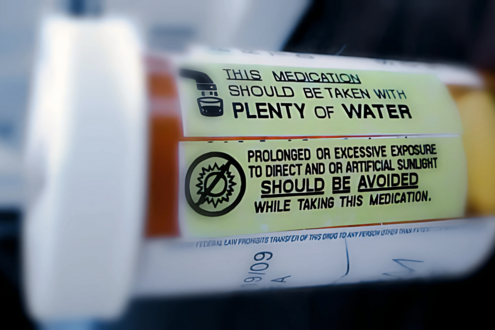
A surprising number of common medications come with an unwelcome side effect: photosensitivity.
A chemically induced change in the skin brought on by a component in medication, photosensitivity, can increase your risk of sunburns, rashes, or other skin issues, even with short sun exposure.
Photosensitivity increases the skin’s reaction to UV rays from sunlight and even artificial light sources, like tanning beds.
Triggered by an interaction between UV rays and certain medications in your system, there are two main types of drug-induced photosensitivity:
- Phototoxic reaction: The most common type of photosensitivity, this occurs when a drug absorbs UV light, leading to a sunburn-like reaction on exposed skin. This can happen within minutes to 24 hours after sun exposure. In some cases, swelling, pain, and blisters may appear.
- Photoallergic reaction: Less common, but more delayed (up to 7 to 10 days after sun exposure), this type of photosensitivity is an immune system response. It can cause an itchy, red rash, often resembling eczema, that spreads beyond the area of exposure.
Medications that can cause photosensitivity
Photosensitivity can occur with both prescription and over-the-counter medications.
Common medications that can trigger photosensitive reactions include:
- Antibiotics: Tetracyclines (like doxycycline), fluoroquinolones, and sulfa drugs
- Diuretics: Often used for high blood pressure or heart issues (e.g., hydrochlorothiazide)
- Retinoids: Used for acne or skin conditions (like isotretinoin)
- NSAIDs: Nonsteroidal anti-inflammatory drugs like ibuprofen or naproxen
- Antidepressants: Especially tricyclic antidepressants (like amitriptyline)
- Antifungals: Griseofulvin, voriconazole, ketoconazole, itraconazole
- Chemotherapy drugs: Various types, including methotrexate and fluorouracil
- Cardiovascular drugs: Atorvastatin, diltiazem, Amiodarone, hydrochlorothiazide, and furosemide
- Oral contraceptives and estrogen
- Acne treatments: Retinoids, Isotretinoin, tretinoin
Not everyone who takes these medications will experience a reaction, but the risk is higher with high doses, prolonged sun exposure, or certain individual sensitivities
If you’re taking a medication that can cause photosensitivity, here are some simple but effective ways to protect your skin:
- Use sunscreen daily: Choose a broad-spectrum sunscreen with SPF 30 or higher. Reapply every two hours, or more often if swimming or sweating.
- Cover up: Wear a wide-brimmed hat, sunglasses, and tightly woven clothing to shield your skin.
- Avoid peak sun hours: Stay in the shade, especially between 10 a.m. and 4 p.m. when the sun’s rays are strongest.
- Be mindful of reflected sunlight: Surfaces like water, sand, and concrete can intensify UV exposure.
- Skip tanning beds: They emit concentrated UV radiation and can trigger or worsen photosensitive reactions.
- Monitor your skin: Watch for signs of unusual redness, itching, or rashes, and let your healthcare provider know if you notice anything concerning.
If you develop a severe sunburn, blistering, or a rash after being in the sun—especially if you’re on a new medication—contact your doctor or pharmacist. They may be able to adjust your dose or switch medications.
Robert F. Sherman, Jr. PharmD, MHA, RPh is the Director of Pharmacy Services at Southwestern Vermont Medical Center.